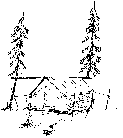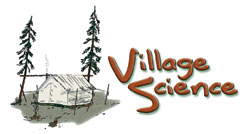Wall Tents

|
Living in a wall tent is very different from living in a house. In some ways it is wonderful. You hear everything that is going on outside . . . dogs, birds, the sound of rain, the river or ocean, and more. There is a tremendous sense of freedom. As there is so little room inside, you want to go outside and be busy. It is hard to be lazy in a tent. On the other hand, in bear country, sleep in a tent is much lighter than in a cabin. Alert dogs are essential for safety and a good night’s sleep. In rainy weather, tents get damp. |
||
FlooringSpruce bark makes an excellent tent floor. It is fairly easy to sweep. It can be removed and shaken outside if necessary. To peel a tree from May to June, it is first ringed low, then ringed as high as the person can reach. A slit is chopped down one side of the tree. The bark is then loosened with a sharpened stick, starting at the bottom, and working around and toward the top. Boards and plywood make a good tent floor, although they need to be nailed down well. As plywood splinters so badly in the weather, I hesitate to use it for tent floor unless it is taken up and stored in a dry place after use. Some people use gravel for a tent floor. All the dust sifts out of sight, so it is self-cleaning. A gravel tent floor always feels cold which is fine during the summer. Spruce boughs make good flooring, particularly in the winter. They insulate well from the cold ground and they smell wonderful. However, they are a fire hazard near the stove. |
|||
|
StoveA tent is warm as long as the stove is burning, even at –30°F. The stove needs to:
Often sparks will fly out of the top of the stove, land on the tent, and make a hole or start a fire. To prevent sparks we used to shoot holes in the top stovepipe with a .22. This allows the sparks a chance to cool before they emerge from the stovepipe. Some people put a screen over the top of the stovepipe, but this hinders the air flow considerably. We once tried to burn tamarack (larch) in a tent stove. It threw so many sparks two of us had to constantly bail water on our tent until the tamarack burned down. No more tamarack! Some people burn dry cottonwood. It doesn’t throw as much heat; it makes a lot of ashes, but there are no sparks. |
||
FoundationThe bottom of the tent must be fastened to logs or boards to prevent the wind from blowing the sides up and to keep drafts out. Mosquitoes have many more opportunities for gaining entrance into a tent than they do in a house. |
|||
Material & ColorA white tent will reflect much of the stove’s heat within the walls and will be very warm. A dark tent, green or brown, will absorb much of the radiant heat, and will be cold and damp. The white canvas of a tent is not a good insulator, but it does contain the warm air heated by the stove. It also reflects the radiant heat of the wood stove. Oil stoves don’t heat tents as well as wood stoves. They don’t radiate heat in the same way. Nylon tents often frost terribly in cold weather. It would be unwise to put a wood stove in a nylon tent as synthetic fabrics melt with that amount of heat. Sparks destroy nylon in a short time. Unlike nylon, cotton canvas allows the moisture from cooking and people’s breath to pass through. It “breathes.” Cotton tents can be treated to be mildew and fire resistant, but both effect the tent’s ability to breathe out moisture. |
|||
RainWater doesn’t run off a canvas tent. It generally runs through it. That is why there must not be any sagging in the roof when the tent is set. Water settles to the low points and drips inside. A tight tent will shed all water except in a severe driving rain. Rain water passes through the tent and runs down any object that is touching the inside surface. |
|||
|
|||
StorageIt is very important to dry a tent well before storing it. Tents are made of natural fibers. They rot and mildew easily in storage. If a tent is dried well, the water necessary for bacteria and mold will not be present. Rotting cannot take place. |
|||

|
Activities
|
||

|
Student Response
|
||

|
Math
|

 Sparks
Sparks One
time, at –30°F, I came back from my trapline, made a fire,
and took a nap. I woke up looking at the stars surrounded by a ring
of fire. My tent burned beyond repair.
One
time, at –30°F, I came back from my trapline, made a fire,
and took a nap. I woke up looking at the stars surrounded by a ring
of fire. My tent burned beyond repair.
 Beds
Beds